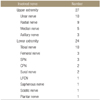Abstract
Purpose
We analyzed the surgical result of schwannoma occurring in the major peripheral nerves of the extremity and factors that influence these surgical results.
Materials and Methods
Fifty-one patients, who were followed for more than 1 year, were included. The mean age was 51 years. There were 23 male cases and 28 female cases. There were 27 cases of schwannoma in the upper extremity and 24 cases in the lower extremity. The involved nerves were classified. The maximal diameter of excised tumors was measured. Clinical and neurological symptoms were analyzed at preoperative, postoperative, and final follow-up. Risk factors of neurological complications were also analyzed.
Results
The mean follow-up period was 20 months. The average maximal diameter of tumors was 2.9 cm. The most affected nerve in the upper extremity was the ulnar nerve in 10 cases, and tibial nerve in the lower extremity in 10 cases. The most prevalent preoperative symptom was Tinel in 38 cases. Clinical symptoms were improved in more than 90% of patients following the surgery. There were 13 cases with preoperative sensory deficits. Symptom improvement after surgery was observed in 9 cases; and symptoms persisted in 4 cases following surgery. At the final follow-up, sensory deficits disappeared in 2 cases and persisted in 2 cases. There were 2 cases of preoperative motor deficits. There was improvement in 1 case following the surgery and persisted in 1 case until the final follow-up. There was a statistical significance between maximal diameter of schwannoma and postoperative neurological deficits (p<0.05).
Figures and Tables
 | Figure 2T1- (A) and T2- (B) weighted coronal image showing round mass involving the radial nerve suggesting schwannoma. (C) Intraoperative photograph showing fascicular injuries of involved nerve due to failure of enucleation. |
References
1. Strickland JW, Steichen JB. Nerve tumors of the hand and forearm. J Hand Surg Am. 1977; 2:285–291.

3. Rockwell GM, Thoma A, Salama S. Schwannoma of the hand and wrist. Plast Reconstr Surg. 2003; 111:1227–1232.

5. Sawada T, Sano M, Ogihara H, Omura T, Miura K, Nagano A. The relationship between pre-operative symptoms, operative findings and postoperative complications in schwannomas. J Hand Surg Br. 2006; 31:629–634.

6. Donner TR, Voorhies RM, Kline DG. Neural sheath tumors of major nerves. J Neurosurg. 1994; 81:362–373.

7. Oberle J, Kahamba J, Richter HP. Peripheral nerve schwannomas: an analysis of 16 patients. Acta Neurochir (Wien). 1997; 139:949–953.
8. James MA. Use of the medical research council muscle strength grading system in the upper extremity. J Hand Surg Am. 2007; 32:154–156.

9. Park MJ, Seo KN, Kang HJ. Neurological deficit after surgical enucleation of schwannomas of the upper limb. J Bone Joint Surg Br. 2009; 91:1482–1486.

10. Kuo YL, Yao WJ, Chiu HY. Role of sonography in the preoperative assessment of neurilemmoma. J Clin Ultrasound. 2005; 33:87–89.

11. Ogose A, Hotta T, Morita T, et al. Tumors of peripheral nerves: correlation of symptoms, clinical signs, imaging features, and histologic diagnosis. Skeletal Radiol. 1999; 28:183–188.

12. Shimose S, Sugita T, Kubo T, et al. Major-nerve schwannomas versus intramuscular schwannomas. Acta Radiol. 2007; 48:672–677.

13. Ujigo S, Shimose S, Kubo T, Fujimori J, Ochi M. Therapeutic effect and risk factors for complications of excision in 76 patients with schwannoma. J Orthop Sci. 2014; 19:150–155.

14. Woodruff JM, Selig AM, Crowley K, Allen PW. Schwannoma (neurilemoma) with malignant transformation. A rare, distinctive peripheral nerve tumor. Am J Surg Pathol. 1994; 18:882–895.

15. Park MS, Chung WC, Yoon SJ, Song JH, Kim SJ. Endoscopic excision of schwannoma of sciatic nerve using hip arthroscopy. J Korean Orthop Assoc. 2015; 50:255–259.

16. Goh TS, Lim JM, Lee JS. Thoracolumbar intradural schwannoma in a patient with osteopetrosis. J Korean Orthop Assoc. 2012; 47:160–163.

17. Levi AD, Ross AL, Cuartas E, Qadir R, Temple HT. The surgical management of symptomatic peripheral nerve sheath tumors. Neurosurgery. 2010; 66:833–840.

18. Kim SM, Seo SW, Lee JY, Sung KS. Surgical outcome of schwannomas arising from major peripheral nerves in the lower limb. Int Orthop. 2012; 36:1721–1725.

19. Artico M, Cervoni L, Wierzbicki V, D'Andrea V, Nucci F. Benign neural sheath tumours of major nerves: characteristics in 119 surgical cases. Acta Neurochir (Wien). 1997; 139:1108–1116.

20. Knight DM, Birch R, Pringle J. Benign solitary schwannomas: a review of 234 cases. J Bone Joint Surg Br. 2007; 89:382–387.




 PDF
PDF ePub
ePub Citation
Citation Print
Print






 XML Download
XML Download